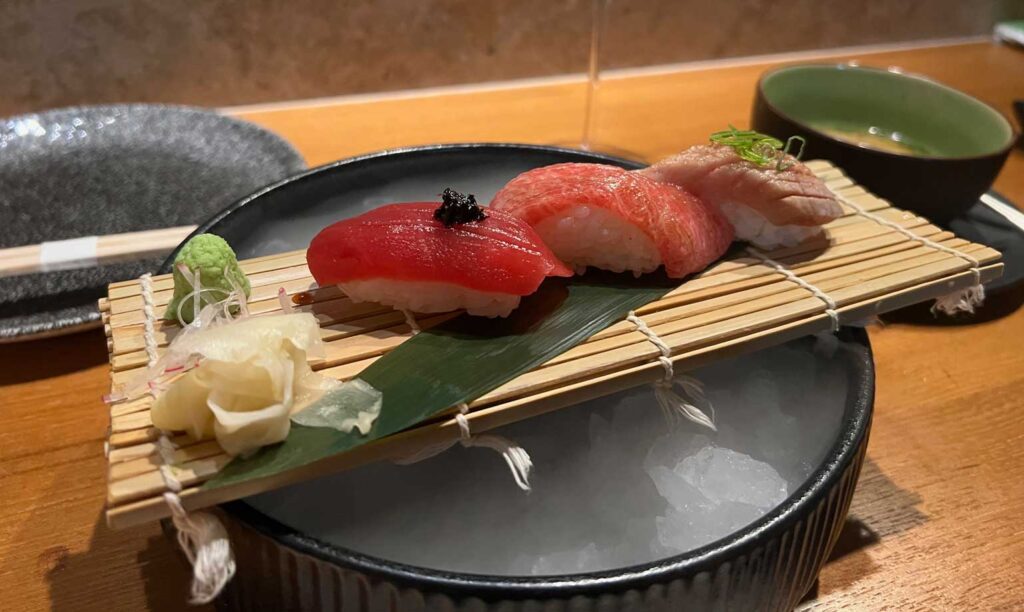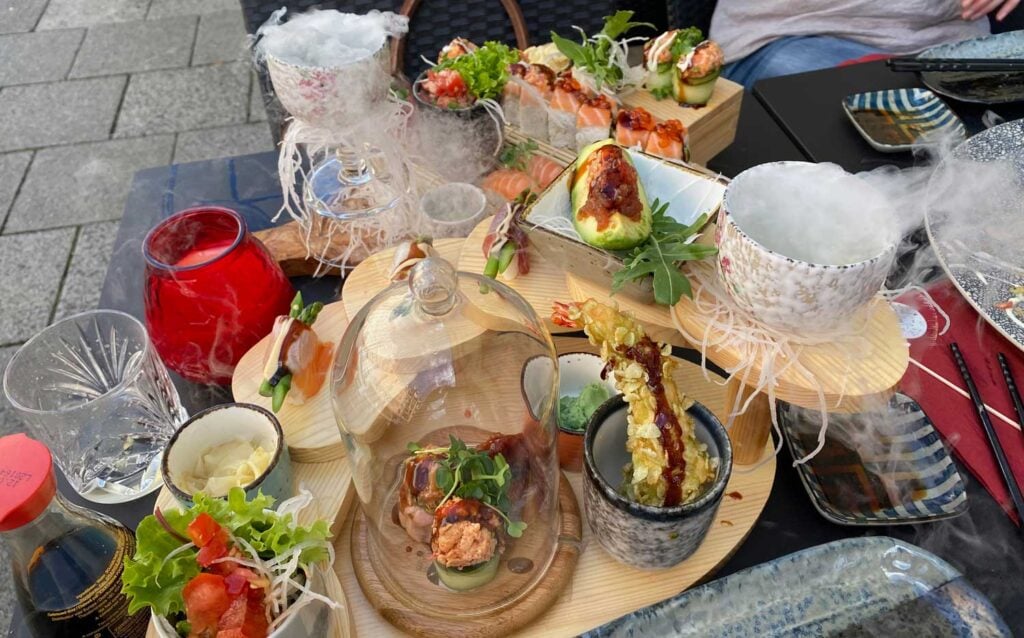A strange trend has suddenly emerged since the 2020s. at sushi restaurants in Munich made wide: Sushi & Sashimi are served on dry ice! What is it all about?
Is this an expression of the highest quality sushi? Or exclusive presentation? Is the dry ice used to perfectly chill the delicate fish for sashimi?
Sushi in Munich - Quality versus Show
First of all: trends come and go in Munich's gastronomy and only very, very few restaurants that are dedicated to Japanese sushi persist at all.
Because just Sushi is seemingly simple, but in reality it is an extremely complicated craft and the preparation work for authentic, high-quality sushi is enormous, often unseen by the customer. We will eventually write in detail about everything that goes into it 😉
"Modern Style" as a code word for lack of craftsmanship
Again and again in recent years, new Trend locations Munich, such as a few years ago in a hotel on the Viktualienmarkt. A Japanese restaurant opened there, to which all the world of course had to make a pilgrimage there - of course, we did too...
However, it didn't take long before the sushi there was only average after a good start and the restaurant disappeared into obscurity again. Recently, the premises were completely rededicated, now no Japanese cuisine resides there.
Many scene restaurants come and go
So it was similar with other locations, always with an impressive, great equipment and really noble ambience and a service perfectly trimmed for sales.
Most of the time these locations live a concept of "sharing appetizers" - to achieve a higher base turnover per head via shared appetizer plates, which present a few very small, easily shareable bites in a great arrangement. But at the latest when looking at the menu or biting into the sushi, the professional realizes that there are no Japanese chefs working there, or if there are, they have been urged to hurry and not to have good taste.
Good sushi is an elaborate craft
"Just send, just send" a (very highly qualified!) Japanese chef who was employed in one of these locations once told us and heard this phrase over and over again.
His bosses there had issued fast delivery of superficial work as a maxim. Accordingly, the menu: there was then no typical Japanese "Sashimi Moriawase" etc., but for example a kind of "New Style Sashimi", where the fish just need to somehow cut, pour a sauce over it and decorate - done.
Not 20 minutes of work for a cook, for a beautiful Sashimi Moriawase Selecting the different types of fish, filleting them everywhere in a suitable, different cut in each case and arranging them all on a plate. It has to be quick, otherwise the guest thinks the service is bad, the store not well organized. Only a few notice the difference, but are dazzled by decorations.
In large locations, quality is often lost in the ambience
Because a great ambience first attracts those who can afford it and you can make a lot of sales with visually spiced up dishes and expensive drinks and feel in the best company when a football star or other starlets are sitting at the table next door.
And with the Keyword football stars we are even directly to the present: again such a restaurant has opened, which is praised by all the world and also has the best reviews on the Internet.
Alone, we could not believe our eyes when we were there ourselves: at first everything looks very great and chic, but when we watch the cooks and see what actually comes to the table, it becomes clear what is being played there.
The difference is immediately noticed by the gourmet
Perfectly succinctly summed it up then a customer who has a lot of experience with sushi food worldwide and currently comes to us almost weekly: "I know a lot of people who go there and are excited - but I don't understand them, because it's really just airport-level system catering". There is no better way to classify it.
We call these "eyewash restaurants" because it's all about ambience and easy reproducibility, quick assembly from a very reduced selection on the menu. The sashimi, for example, is not cut fresh from the fish fillet, but comes pre-cut from the refrigerated counter and is just arranged.
But these arrangements then have it in them and make each small dish about 3-4x bigger (and of course correspondingly more valuable in the guest's perception).
New trend in all price ranges: Sushi & Sashimi on dry ice
Because it is brought to the table on dry ice and the guest is amazed at the great atmosphere that is exuded. And pays premium prices for it.
Alone with the Japanese idea of skillful arrangement (Moritsuke) has nothing to do with it at all: tuna, salmon, white fish are all simply on ice somehow, there is not one main actor staged and the other varieties arranged around it.
"Pan-Asian" remains Warning signal for lovers of Japanese cuisine
But the strange trend of serving sushi in conjunction with dry ice isn't just something we're seeing at expensive restaurants - it's also something we're seeing a lot of. but also with so-called modern pan-Asian cuisine.
Whereas "pan-Asian cuisine" has always been a buzzword that actually says you kind of want sushi on the menu, but can't or won't consistently afford the painstaking craft of Japanese cooking.
We were in Munich a year or two ago in a new "sushi" store and were still surprised when everything came to the table arranged on little towers and stairs served with dry ice.
At that time, we were still curious about it, but a special taste experience did not want to set at all. Because in terms of taste, the dry ice at best does not work at all and in the end the taste was quite monotonous due to too one-sided salmon emphasis - it also does not help if some of the salmon pieces have a sauce on it that is actually completely unsuitable for sushi.
In the last 1-2 years, more and more restaurants are now attracting attention with wildly decorated sushi platters and presentation with fog & smoke from dry ice.
So we looked into the matter and researched whether dry ice is perhaps a trend in Japan or makes sense in some way? Spoiler: it does not.
Why dry ice does nothing for sushi
In the end, it's like this: Sushi is a sophisticated craft. Diners' expectations of a restaurant in Munich are often diametrically opposed to the consistent and complex handiwork required to produce a wide selection of really good sushi. Because the guest wants it to be fast, to look great - and experience shows that many Western guests do not understand the fine, almost meditative culinary delights that Japanese cuisine is actually capable of.
Today, effects like dry ice are used to cover up just as other pseudo-sushi restaurants cover up the often lacking rice flavor with thick sauces, exciting flavor combinations, and so on.
In fact, dry ice has nothing at all to do with sushi or sashimi. In Japan, dry ice is actually only used to cool food in very special cases for transport over longer distances or for longer periods in special containers.
Contradicts the details that good Japanese cooks pay attention to
Smoke is also used at wedding ceremonies and concerts in Japan. However, dry ice smoke at wedding ceremonies is perceived as an expression of unpolished presentation rather than a little ridiculous, so the Japanese explain it to us.
Also with regard to the philosophy of the Moritsuke dry ice is completely out of place when serving. It conveys neither a sense of seasonality, nor of care in coloring, nor of culinary skill.
For these reasons, dry ice is almost never used in Japan for the preparation of Sushi or Sashimi used. Only in the presentation of desserts, however, there may be times when dry ice is used.
Why dry ice is out of place with sushi & sashimi
Dry ice has a Temperature of about minus 80 °C, and the air around the ice is cooled to a mist that becomes visible as white smoke.
In contrast, the ideal temperature for good sushi is when the Sushi rice in the preparation human skin temperature (36-37 ° C). so that it feels somewhat warm or like room temperature when eaten.
However, it should not be noticeably cold - and especially should not be served cold, because the rice with rice vinegar will otherwise become hard and grainy.
The optimum temperature for tasting Sashimi is 8 to 9 degrees, which in conjunction with the temperature of the human body corresponds to about 12 degrees Celsius when placed in the mouth.
Therefore, too much cooling spoils the taste. Tuna in particular must not be too cold if it is to develop its full flavor experience.
Why sushi is presented on dry ice
Even if the possible negative impact on taste might be negligible, the dry ice presentation distracts from the details that recognizably distinguish good sushi from bad sushi.
Because it's really about the best taste experience. One guest may have this by eating 10x salmon nigiri, but the other may have it by eating a nice sequence of well successive Nigiri and Makimono eats
Above all, the rice should be properly seasoned, the fish properly cut and the craft properly executed.
And this is exactly the crux, because this first requirement simply can not meet all restaurants, and not all chefs who make sushi.
Usually trained by a chef who has received professional training at a sushi academy in Japan, after that still months and months in practice to get at least the roles somewhat right.
At least that's the case with us, a chef from the Sushi Academy in Japan is still years away from making our nigiri or sashimi.
From MoritsukeThe presentation with wild salad leaves, effects such as dry ice, and intense sauces. The presentation with wild salad leaves, effects such as dry ice, and intense sauces, however, overplays above all exactly what is important. for the taste arrives
- how is the sushi shaped?
- how is the rice seasoned?
- how is the fish cut?
All these things are easily overlooked - but you can taste them.
But anyone who puts a mat for rolling sushi in dry ice like a stick in rice or builds towers of colorful combinations of actually only a few uniform ingredients (salmon avocado rice), proves above all that he has little idea of Japanese taste and Japanese culture. And most of the time, these restaurants lack the basics, they are not works of art, often lacking in craftsmanship and not worthy of representing sushi in terms of taste.
Conclusion: Dry ice does nothing for sushi & sashimi, but covers up a lot
It's always nice when restaurateurs find ways to prepare high-quality food in such a way that eating is a pleasure, an enjoyment, an experience - and the guest can also notice and appreciate the value of the food.
But dry ice has no place in the presentation of sushi & sashimi.
It often masks weaknesses in craftsmanship and a poor understanding of Japanese flavor.
Everyone should eat the sushi they like. There is an infinite amount to learn and consider if you want to make sushi the way it usually tastes in Japan. Getting involved with that taste, exploring it, getting to know it and being able to differentiate it yourself is also a learning curve for those of us who didn't grow up in Japan. And for good reason, presentation with dry ice is completely unknown there, because the art of sushi lies primarily in making different ingredients shine through a great deal of experience and knowledge.
And the art of the best presentation of sushi thus lies on the focus of the perfect craft and the experience of the chef - not on the show effect from the construction kit.








